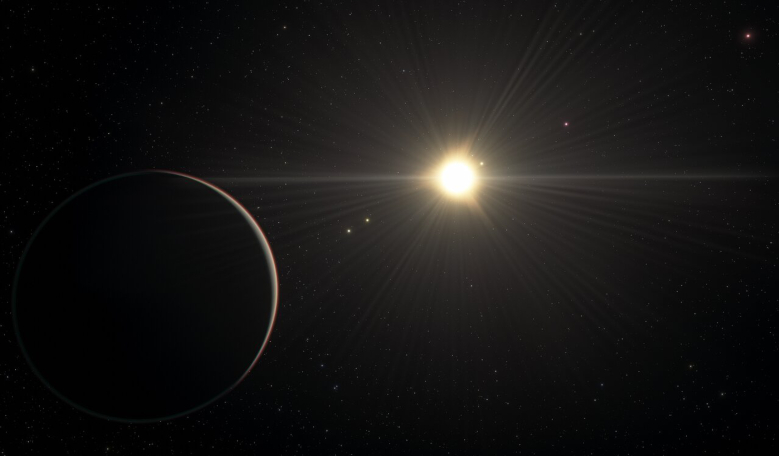200 light-years away in the constellation of Sculptor, astronomers have found a system that boasts six exoplanets, five of which are locked in a rare rhythmic dance around their central star; a finding that could provide important clues about how planets, including those in our own cosmic backyard, form and evolve.
Since its launch on 18 April, 2018, NASA’s Transiting Exoplanet Survey Satellite (TESS) has been busy searching the skies for exoplanets in orbit around the brightest dwarf stars.
To date, the planet hunter has found 98 confirmed exoplanets and 2453 candidates waiting to be verified.
Exoplanet candidates which appear the most promising are put into the TESS Objects of Interest (TOI) Catalogue for further follow up and it was during the first release of candidates that planets within the TOI-178 system caught the eye of astronomers.
At first scientists thought they had spotted two planets going around TOI-178's central star in the same orbit. However, after using data from the European Space Agency’s CHEOPS satellite, alongside the ground-based ESPRESSO instrument on ESO’s VLT and the NGTS and SPECULOOS to have a closer look, the team saw that something entirely different was going on.
“Through further observations we realised that there were not two planets orbiting the star at roughly the same distance from it, but rather multiple planets in a very special configuration,” says Adrien Leleu from the Université de Genève and the University of Bern, Switzerland, who led a new study of the system published today in Astronomy & Astrophysics.
The observations showed that TOI-178 harboured at least six planets in the super-Earth to mini-Neptune regimes, with orbital periods lasting from just under two days to just over 20 days.
Exciting as the find was, the system held even more surprises; all but the one closest to the star were locked in a complex chain of resonance.
Planets are in resonance when, for example, every time one of them orbits its host star once, the next one goes around twice. In our solar system, Neptune and Pluto are in a 3:2 resonance. For every three orbits of Neptune around the sun, Pluto completes two orbits.
Multi-planet systems containing six or more exoplanets are relatively few and far between and finding one with chains of planets in mean-motion resonances is even more rare. As resonances can greatly increase the stability of planetary configurations by preventing close encounters and collisions, identifying how and where planets like this form is a very important but as yet unanswered question in planetary science.
As such, the TOI-178 system is a key discovery as its planets are in one of the longest chain of resonances yet discovered (the TRAPPIST-1 system is another such example); the five outer planets follow a 18:9:6:4:3 chain, meaning that the second planet from the star (the first in the resonance chain) completes 18 orbits, the third planet from the star (second in the chain) completes 9 orbits, and so on.
In fact, the team had initially only found five planets around the central star, but by following this resonant rhythm they calculated where in its orbit an additional planet would be so that they could look for it when the next observing window appeared.
“The orbits in this system are very well ordered, which tells us that this system has evolved quite gently since its birth,” explains co-author Yann Alibert from the University of Bern. If the system had been significantly disturbed earlier in its life, for example by a giant impact, this fragile configuration of orbits would not have survived.
Another curious aspect of the system is that while the orbits of the exoplanets are neat and well-ordered, their densities are not.
“It appears there is a planet as dense as the Earth right next to a very fluffy planet with half the density of Neptune, followed by a planet with the density of Neptune. It is not what we are used to,” says Nathan Hara from the Université de Genève, Switzerland, who was also involved in the study.
This is in contrast to our own Solar System whereby denser planets are found closer to the Sun and the fluffy, low-density gas planets are farther out.
“This contrast between the rhythmic harmony of the orbital motion and the disorderly densities certainly challenges our understanding of the formation and evolution of planetary systems,” says Leleu.
Although none of the six exoplanets found lies in the star's habitable zone – an area in which liquid water might be found on a planet’s surface – the researchers suggest that by following their earlier plan of continuing the resonance chain, they might find additional planets that could exist in or very close to this zone.
In addition, when ESO’s Extremely Large Telescope (ELT) begins operating later this decade it will be able to directly image rocky exoplanets in a star’s habitable zone and even characterise their atmospheres; a feature that will help scientists to understand systems like TOI-178 in even greater detail than before.











